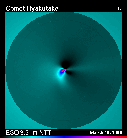Comet Hyakutake - Update (March 26, 1996)
Read More:

Dust Jets (ESO NTT Image)
This is another update to my earlier reports about observations of this comet, published on the ESO Web on March 12 , March 22 and March 25 . It is based on information received directly by email and also from IAU Circulars and on other Hyakutake WWW pages.
Richard M. West (ESO)
March 26, 1996; 15:00 UT
![]()
Fragments observed
CCD observations made at the Pic du Midi Observatory on March 24 show two condensations in the dust tail, located at about 400 and 2000 km projected distance from the nucleus, respectively. Two of these images may be accessed here ( March 24 [GIF, 88k] and March 25 [GIF, 78k] ).
Francois Colas from the Pic du Midi Observatory in France reports that one of the condensations was also observed on March 25. He estimates that the ejection speed of the fragment is about 12 meters/second, and that the magnitude is about 11.
These condensations are much fainter than the central one in which the cometary nucleus is situated and it must be assumed that they surround small, icy fragments only. Thus their presence at this time does not necessarily mean that the main nucleus has split, but rather that small pieces have broken off. Still, the relatively early epoch of this event, more than one month before perihelion passage on May 1, 1996, gives some hope that more may follow, thereby further contributing to the overall brightness of this splendid comet.
The orbit improved
A new ephemeris (March 25) by Don Yeomans is now available. It is based on 362 positions, obtained between January 1 and March 23, 1996. The semi-major axis of the new orbit is about 670 A.U., i.e. the most distant point (aphelion) is about 200,000,000,000 km from the Sun, or 34 times the mean heliocentric distance of the outermost known major planet, Pluto. The corresponding orbital period is about 17,250 years.
More molecules detected
Further observations with the James Clark Maxwell Telescope on Mauna Kea (Hawaii), performed on March 15 and 16, confirm the presence of CO, HCN, H2CO, and CH3OH in the coma (IAUC 6353) and also show gradually increasing production rates. Moreover, and for the first time, HNC and CS have been detected. Of these, the HNC molecule (isocyanic acid) has never before been detected in a comet and is particularly interesting, because it is very unstable. It has earlier been observed in interstellar clouds at a ratio to its isomer HCN (cyanic acid) of HNC/HCN = 0.004 to 1; it is found to be 0.07 in Comet Hyakutake. The measured ratio may possibly help to elucidate the origin of HNC.
From these measurements, the progressive heating of the nucleus and its constituents can be followed. For example, on February 28, the kinetic temperature of CH3OH (methanol) was 19 K, on March 12 it was 46 K and now, on March 16, it was 55 +- 8 K.
HST observations to begin
Observations with the Hubble Space Telescope are scheduled to start today.